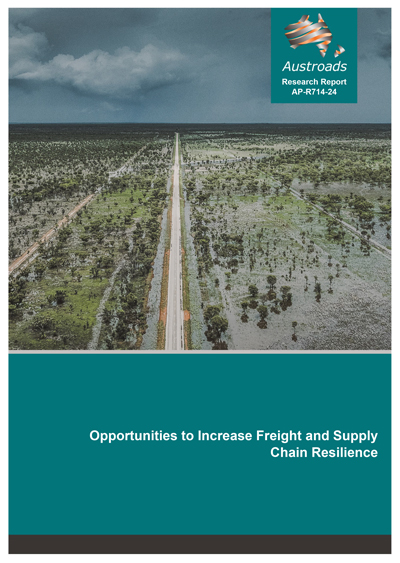Freight

- Publication no: AP-R714-24
- ISBN: 978-1-922994-45-5
- Published: 21 October 2024
- PDF (free) Download
In Australia and New Zealand maintaining road connections to communities in rural and/or remote areas is vital as often there is a lack of alternative connections. Where there are few road options to communities, these are known as lifeline routes. Lifeline routes ensure essential connectivity for communities, particularly during emergencies or natural disasters when alternative routes are cut-off due to natural disasters such as floods or earthquakes.
This report presents the work undertaken to update the Lifeline Risk Indicator Tool, first published in 2016. This tool has two purposes. First is to identify lifeline freight routes and allow road managers to establish a lifeline route network. Second is to rank investments in lifeline routes in terms of economic and social impacts.
The update process included a literature review, road management consultation, case study development and risk analysis.
The tool and user instructions can be accessed on the Austroads website austroads.info/lifeline.
Watch a webinar presented by Ben Mason, Dr Stacy Rendall and Valentin Perez, describing the process undertaken to update the tool and a practical run through of how the web-based Lifeline Risk Indicator Tool can be used.
- Summary
- 1. Introduction
- 1.1 Background
- 1.2 Study scope and purpose
- 1.3 Structure of this report
- 2. Evidence Review
- 2.1 The 2016 Austroads Lifeline Risk Indicator tool
- 2.2 Lifelines elsewhere
- 2.3 Freight and infrastructure resiliency and associated tools
- 2.4 How do these tools relate back to the Austroads lifeline tool?
- 3. Summary of Road Manager and Policy Maker Consultation
- 3.1 Approach to consultation
- 3.2 Summary of key findings
- Lifeline route definition
- Approach to investment
- Use of the 2016 tool
- Use case for the updated tool
- Scope of the tool
- Changing risks
- 4. Case Studies
- 4.1 2016 Kaikōura earthquake
- 4.2 2020 Black Summer bushfires in Gippsland
- 4.3 Ootann Road
- 4.4 Stuart Highway flooding
- 5. Risk Analysis
- 5.1 Overview of key risks
- 5.2 Climate change and natural disaster risks
- 5.3 Rainfall and heavy rainfall
- 5.3.1 Australia
- 5.3.2 New Zealand
- 5.4 Average temperatures
- 5.4.1 Australia
- 5.4.2 New Zealand
- 5.5 Fires
- 5.5.1 Australia
- 5.5.2 New Zealand
- 5.6 Sea level rise
- 5.6.1 Australia
- 5.6.2 New Zealand
- 5.7 Earthquakes
- 5.7.1 Australia
- 5.7.2 New Zealand
- 5.8 Climate change trends and projections
- 5.8.1 Climate trends
- 5.9 Climate-related impacts on roads network and infrastructure
- 5.10 Other risks
- 6. Updates to the Lifeline Risk Indicator Tool
- 6.1 Summary of process
- 6.2 Scope of updated tool
- 6.3 Key changes to 2016 tool
- 7. How to use the Updated Lifeline Risk Indicator Tool
- 7.1 Assessment criteria and outputs
- 7.1.1 Assessment module 1 – Lifeline route identification
- 7.1.2 Assessment module 2 – Risk assessment and response analysis
- 7.2 Application to example routes
- 7.2.1 Arthur Highway (Sorell-Tasman Peninsula)
- 7.2.2 Esk Highway (St Marys Pass)
- 7.2.3 Bass Highway (Cam River Bridge)
- 7.2.4 Inputs into the updated tool
- 7.2.5 Outputs of the updated tool
- 7.2.6 Comparison of the updated tool against the 2016 tool
- 7.2.7 Changes to tool based on examples
- 7.1 Assessment criteria and outputs
- References
